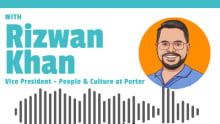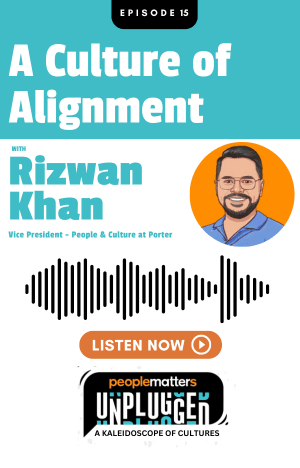For inclusion to work, it needs to become a leader’s agenda: CEO, NASSCOM Foundation

Nidhi Bhasin is the CEO, NASSCOM Foundation.
A social development sector professional with over two decades of experience, Nidhi wears many hats and has proven skills in program and team management, regulatory understanding of CSR law, finance, and compliance, among others.
Nidhi is extremely passionate about providing equal opportunities to all, technology for social good, and women and youth development.
At NASSCOM Foundation, she is working towards pivoting the organisation into focussed strategic growth by providing employability-driven skills to the underserved youth, encouraging and incubating tech for social good, and fostering women's entrepreneurship.
Nidhi is an alumnus of the Delhi School of Social Work (Delhi University).
In this exclusive interview with People Matters, Nidhi talks about the adoption of inclusion as a business agenda, technology being a DEI ally and advises leaders on how to approach conversations challenging meritocracy in diversity hiring.
Read on for highlights from the interview.
What are some of the biggest challenges prolonging sustainable DEI? How can organisations overcome these?
Inclusion is a powerful enabler of business growth. However, there is still a long way to go before we can honestly say that Inclusion has been mainstreamed in our business environments and beyond it. And one of the biggest challenges when building an inclusive environment is the adoption of inclusion as a business agenda.
Sustained progress on inclusion requires complete buy-in from the leadership. One stumbling block in adoption on inclusion is when it ends up as an ‘also’ responsibility with the HR, Women leaders forum or Diversity leader.
Beyond lack of knowledge and awareness of the policies among employees, what also hampers driving inclusion is when these policies are not driven by the senior most leadership.
Another barrier to driving Inclusion within organisations is resistance to change. Diversity and Inclusion is not limited to introducing best practices within the workplace but also to a great extent involves sensitising about proper behaviour and mindset to support flexible policies at the workplace actively. All of these segments require similar efforts to be successful and are each just as important as the last. But to underline it all, for inclusion to work, it needs to become a leader’s agenda, a business agenda.
At NASSCOM Foundation, we work on furthering the Inclusion agenda not just within the industry but beyond it as well. Inclusion has a very powerful ally in technology. With the right use of technology, we can look at building an Inclusive environment not just in industries but also for the country. Whether through our programs or inclusion workshops, summits, discussions, and comprehensive evaluations our objective is to ensure that this change is part of business models, supply chains, CSR programs and any organisational outreach.
With a multi-generational workforce working in a hybrid environment, how should organisations approach weaving in empathy, inclusion and allyship in the flow of work?
Inclusivity cannot be achieved in a day. Inclusion is intentional. And when mainstreaming it, it needs to be an evolving process, a process that works towards integrating inclusion and allyship as part of the company’s DNA. With the COVID-19 pandemic leading us into a new reality at work, there can’t be a better opportunity to embed more inclusive practices at remote workplaces.
A workplace that is equitable and inclusive needs its leaders to be well-trained in inclusive strategies. There is one key trait that all great leaders possess - empathy.
The starting point needs to be simple initiatives such as creating awareness, supporting and encouraging people from diverse communities to lead in their roles, measure and evaluate inclusion, retain diverse talent, bringing together latest technologies that support fostering inclusion to bridge the gap for PWDs, LGBTQIA and the trans community can open doors to fostering a culture of empathy, allyship and inclusion at workplace.
Especially in hybrid environments, organisations should be more open, transparent, and focus on frequent communication with the employees.
It is imperative for organisations to build an environment where employees enjoy working together and contribute to the success of the organisation.
How can leaders approach conversations challenging meritocracy in diversity hiring? What has your approach been?
Diversity has its own merits and organisations across industries have seen improvement in decision making, problem solving, creativity, innovation etc. when there is a diverse group of people working. Meritocracy- the word in plain sight says hiring/ promoting candidates solely based on their performance and talent.
And Inclusion means – everyone together! This implies Inclusion really means being chosen on Merit. A journey where every opportunity is merit based, is where inclusion has really taken off.
Leaders can achieve inclusive meritocracy by recruiting from the widest pool of people from all categories, use of latest technologies to upskill employees and providing them with an opportunity to showcase their talent. And of course, there is unconscious bias to address.
Motivating your employees, developing an empathetic approach, and encouraging a listening culture are few ways leaders can approach the meritocracy in diversity hiring.
How can organisations steer clear of tokenism in their hiring and cultural transformation efforts?
Embracing tokenism just for face value, often is the start of a self-inflicted trap. You can change your hiring strategies to seem more diverse, however until you honestly embrace inclusion, diversity will just be a thorn in your organisation’s culture.
A truly inclusive organisation will stand out as Inclusion will not be just an HR or DEI leader’s agenda, but a business agenda.
The day when as a leader you make it YOUR agenda, a business leader’s agenda, make it visible and hard-edged like all other business goals, it will no longer be just tokenism.
What are some of the biggest shifts that employers must be prepared for on the DEI front in the new now of work?
The COVID-19 pandemic has been a bittersweet turning point for DEI. The last two years have brought a lot of change to workplaces, but most importantly, it resurfaced the systemic challenges that underrepresented employees are facing in our society, and the consequence these challenges can have if left unaddressed.
One of the most important shifts will include exploring tech-enabled DEI solutions. Leaders should harness the power of tech-enabled solutions to enable successful DEI outcomes. Another shift will be recruiting and hiring talent from a variety of backgrounds that will enable a diverse workplace and foster productivity through amalgamation of different minds.
There is also a need to create a sustainable diversity and inclusivity ecosystem by enabling equal opportunity for all. The future of DEI initiatives will bring greater emphasis on recruiting and providing growth opportunities to women.
Employers must also be prepared for equipping and empowering everyone to have honest conversations and provide resources and tools that help build the psychological safety needed for people to have these conversations.
What are your top three DEI priorities for 2022?
At NASSCOM Foundation, we believe that Inclusion needs to be mainstreamed beyond the industry. In fact all our programs are proof in point. One common thread that binds all NASSCOM Foundation programs is the use of technology to create Inclusion for All.
Towards that our priorities include:
- Investing more in the women workforce and towards women entrepreneurs: Whether through our programs, for the country’s trillion-dollar dream or within the organisation, we believe building a sustainable environment for encouraging women to become leaders, is key. We are ensuring that technology becomes an enabler in this journey through our skilling programs and women entrepreneurship initiatives.
- Mandatory awareness and sensitisation workshops: Raising awareness about diversity and inclusion is important to create a happy and positive work environment. Diversity training allows employees to think about inclusion and how they can make conscious efforts to make everyone feel comfortable and valued which will contribute to business growth. This will also help our program managers who conceptualise initiatives to help people at the last mile, prioritise different groups and create inclusive environments.
- Using TechForGood to mainstream inclusion: Inclusion is a core pillar of success in organisations. Inclusion is also the core pillar of achieving all the Sustainable Development Goals (SDGs). Technology and Inclusion lie right at the heart of it. For an organisation, an industry and the country to adopt the cause, it is vital that we develop a holistic approach towards inclusion. And technology can play a huge role in paving that way for us.













